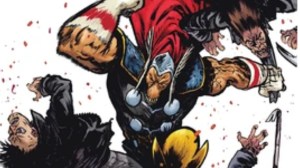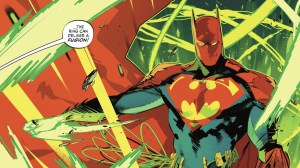If you remember the first wave of Image Comics in the 1990s, then Damage #1 will undoubtedly provide you with a sense of nostalgia. Those comics have garnered a negative connotation over time, largely due to being late, underwritten, and the force behind a bubble that almost destroyed the direct market. However, these artist-driven titles had a lot to offer, and for those that enjoyed their merits Damage is a series that promises all of the good with none of the bad.
Videos by ComicBook.com
The emphasis of the first issue is entirely on Daniel and Miki’s artistic collaboration. While there is a plot, it is given exactly enough space to form a coherent story. Even the premise of Damage is focused on providing a playground for a pencil and inks team with a blockbuster style. It’s the story of Ethan Avery, a soldier transformed into a Hulk-like monster, escaping confinement and fleeing from those who would seek to control him. What this really means is that there’s an enormous brute ready to destroy city blocks and duke it out with mechanized suits in splashes and spreads across the issue.

Daniel draws a smashing poster, literally and metaphorically. Damage is the sort of creation that encourages readers to examine its grotesqueries on each page. While comparisons to the Hulk are inevitable, Damage is a less-organic creation. The character is composed of layers, some of them smooth flesh, some scar tissue, and some entirely alien or mechanical. What rests on the page is truly bizarre and entices the eye to check for ridges on the spine or the movement of the eyebrow in each new two-page layout. Crumbling buildings and high-tech military gadgets laid waste are background for the size and movements of Damage across the page.
Miki’s inks draw out the detail of every scene and make Daniel’s poster-like designs function exceedingly well, in and of themselves. The drawback is that the central action sequence in Damage #1 reads more like a greatest hits collection than a sequential narrative. It’s the flashes of big moments after a blackout. This is where mileage will vary most for readers as the excitement lies in essentially static representations that give everything to a single instance of explosive action. The script does allow them to land best by avoiding any gratuitous dialogue or exposition. It understands that these illustrations are the central draw of the comic, for better or worse.

Damage #1 is a damn cool comic. It’s the kind of book you want to cut out pages from and post to your door in middle school. That’s not a slight either. This slam-bang beat-’em-up formula is played to perfection and is everything Metal advertised itself to be. It’s all about wild-looking characters tearing about cities and foes. That concept works in these pages because it has artists capable of pulling it off. Damage is all about impact and it plants its big moments like a punch. It’s a reminder of how this sort of comic is supposed to be done.
Grade: B
Written by Robert Venditti
Pencils by Tony S. Daniel
Inks by Danny Miki
Colors by Tomeu Morey








